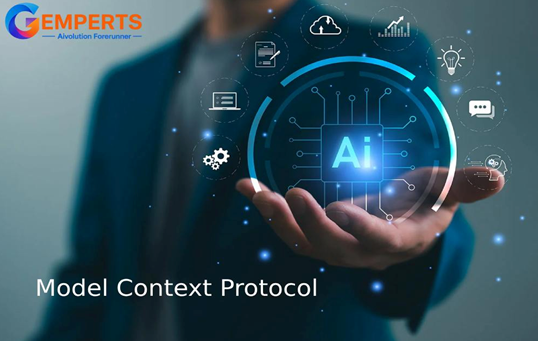MCP: Overcoming the Challenges of AI Integration
LLMs transform tech with human-like responses and automation-but often fall short on real-world context and accuracy.

Making LLMs Smarter: How Gemperts is Powering AI with Real-World Context through MCP
Large Language Models (LLMs) have dramatically changed how we interact with technology. Whether through intelligent chat assistants or enterprise copilots, these models are capable of generating human-like responses, processing unstructured data, and automating complex workflows.
But for all their power, LLMs often operate in a vacuum. They lack access to the real-time data and tools your business relies on—CRMs, Slack channels, internal APIs, file systems—limiting their true usefulness.
Enter Model Context Protocol (MCP)—a game-changing standard that gives LLMs the context they need to be truly helpful in real-world scenarios.
What is Model Context Protocol (MCP)?
MCP is an open communication standard that bridges the gap between LLMs and the tools they need to interact with. It simplifies how AI connects to systems like databases, web services, APIs, and document storage—without needing to build a unique integration for each one.
Think of it as the USB-C of AI—a single, universal connection format that makes it easy to plug different systems into your AI models.
Why Traditional Integrations Don’t Scale
When building AI assistants without MCP, you often end up with:
- Custom connectors for every individual tool
- Different APIs, data formats, and authentication flows
- Difficult-to-maintain integrations that break with each update
This fragmented approach doesn’t scale well in complex enterprise environments.
With MCP, you gain:
- One unified protocol across all systems
- Reusable architecture that grows with your needs
- Cleaner, modular design that separates AI logic from tool-specific wiring
- Easier security enforcement through clearly defined boundaries
MCP Architecture: Modular and Maintainable
MCP operates on a client-server model designed for flexibility and scalability:
- MCP Host: The AI-powered application (e.g., a chatbot, IDE copilot, or enterprise agent) that needs to interact with external systems.
- MCP Client: A lightweight module inside the host that communicates with one or more MCP servers.
- MCP Server: Connects to tools, APIs, data, and exposes them in a structured way the AI can understand.
Key MCP Server Components:
- Tools: Functions the AI can invoke (like sending a message or querying a database)
- Resources: Static or dynamic data the AI can read (documents, records, logs)
- Prompts: Guidance on how the AI should use a tool or resource effectively
- Data Connectors: Secure access to both local files and remote services
Each component is defined in a way that gives LLMs structured access—without exposing sensitive business logic.
How MCP Works in Practice
- Initiation: Host app spins up clients.
- Discovery: Clients query servers for available tools, data, and prompts.
- Context Sharing: Structured context is passed to the LLM.
- Decision: LLM decides it needs to call a tool or fetch data.
- Execution: Server performs the requested task.
- Response: Data or result is returned to the LLM.
- Completion: The model uses the result to respond intelligently
Why MCP Matters for Real-World AI
Standardization
A single protocol simplifies how you connect systems, speeding up development and reducing maintenance.
Scalability
Add new tools without rewriting core logic—just spin up another MCP server.
Security
MCP defines clear interaction boundaries, minimizing risk and improving auditability.
Modularity
Each part (host, client, server) can evolve independently, making your stack more future-proof.
Cross-Platform Support
Whether you’re using different LLM vendors or deploying across cloud and on-prem environments, MCP works seamlessly.
Where MCP Makes an Impact
- Enterprise AI Assistants: Pull real-time data from ticketing systems, knowledge bases, or messaging apps
- Developer Tools: Enable AI copilots to access GitHub issues, logs, or test environments
- Internal Automation: Summarize internal documents or auto-generate reports
- Cross-Departmental Agents: Coordinate workflows across sales, operations, and support tools
MCP vs Traditional APIs: Know the Difference
Feature | Traditional APIs | MCP |
Integration Effort | High (custom per tool) | Low (plug into a standard server) |
Flexibility | Fixed behavior | Dynamic interactions via tools/prompts |
Scalability | Poor | Excellent with modular servers |
Best For | Deterministic systems | AI agents, assistants, copilot tools |
If you’re building systems with rigid, predictable behavior—traditional APIs may still be your best choice. But if you’re designing flexible, intelligent agents that respond to changing needs, MCP is the better tool.
Conclusion: A Smarter AI Future with Gemperts
Model Context Protocol isn’t just another spec-it’s a foundation for next-generation AI. By standardizing the way models interact with systems, MCP unlocks powerful AI that’s no longer siloed or blind to your organization’s context.
At Gemperts, we specialize in building intelligent, integrated AI systems using the latest in LLMs, computer vision, and NLP. Through technologies like MCP, we empower businesses to go beyond generic AI-giving their assistants real access to tools, documents, and APIs in a structured, secure, and scalable way.
Whether you’re building an internal chatbot or a full-scale enterprise agent, Gemperts helps you build context-aware AI that actually understands your business.
